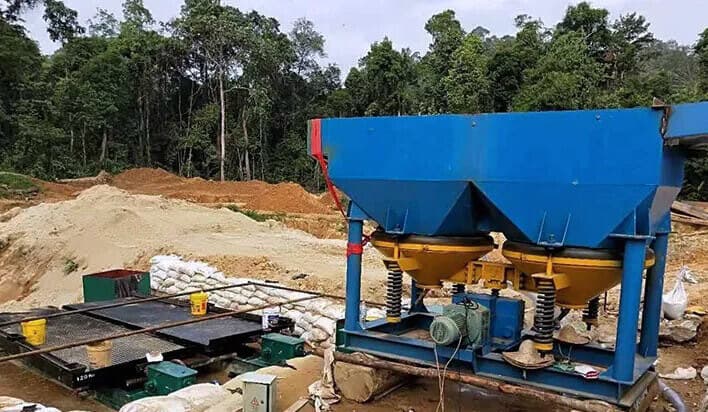Barite, also known as barytes, is a naturally occurring mineral with the chemical formula BaSO4. With its high specific gravity and chemical inertness, it is used in oil and gas drilling fluids and in producing ceramics, paints and plastics. However, impurities such as quartz and calcite limit its commercial value. The beneficiation process is adopted to improve the purity and quality of barite ore. To meet the stringent quality requirements of these industries, barite must undergo a beneficiation process to remove impurities and increase its purity. Each stage is vital in optimizing the quality and value of barite for different applications, from mining and crushing to flotation and drying. The general process of barite beneficiation includes crushing, screening, gravity separation, magnetic separation, flotation, drying, etc.
Barite Beneficiation Process
1. Barite crushing & grinding process
The process involves crushing and grinding barite ore to reduce the desired size. It mainly involves using jaw crushers, impact crushers or cone crushers to reduce the size of barite raw material. After being crushed by these crushers, the size of the particles can be further reduced by grinding with a ball mill, raymond mill or other grinders.
- First, the mined barite is crushed through a jaw or cone crusher for preliminary classification. This step crushes the ore from large chunks into small pieces and prepares it for further processing. The crushed materials then pass through an impact or cone crusher for a secondary crushing stage to obtain finer particles.
- The finely divided barite is then sifted through a vibrating screen to separate particles of different sizes for use in various applications.
- If the fineness fails to reach a reasonable particle size, it can be passed through the ball mill to the minimum particle size. Oversized material is returned to grinding, while material of the correct size is sent to storage silos or used directly in downstream processes.
By crushing materials into smaller pieces and obtaining finer particle sizes through multiple stages of crushing, grinding and screening, manufacturers can ensure consistent quality and optimal final product performance.
2. barite gravity separation process
The gravity separation process is a method that uses gravity difference to separate barite ore. It is based on the density difference between barite and gangue minerals. The specific gravity of barite is 4.2-4.6, while the particular gravity of gangue minerals such as quartz and calcite is 2.6-2.8. This large density difference makes gravity separation ideal for separating barite from other minerals.
- A jig separator usually separates The barite ore from the gangue minerals. A jig works by pulsing water through a bed of ore particles, causing heavy particles to settle at the bottom while lighter particles float to the top. This method is widely used in barite processing plants due to its high recovery rate and low energy consumption.
- Another widely used barite gravity separation device is shaking tables. It consists of a platform with corrugations or grooves and an inclined surface that vibrates back and forth. Due to their ease of operation and low cost, shaking tables have become popular for many small barite mining operations.

2. barite flotation separation process
The flotation separation process is a critical step in the mining industry. The barite concentration can be significantly increased through this process, making it easier to extract and use in various industries, from oil drilling to paint production. Froth flotation utilizes chemical reagents to selectively attach and float only valuable minerals while leaving behind gangue particles.
- The grade and recovery of the desired barite concentrate can be optimized by adjusting various parameters during the flotation process, such as pH, reagent dosage, and slurry density.
- Barite flotation separation is an environmentally friendly option. Unlike other methods that require the use of harmful chemicals or produce excessive waste, this process uses natural substances such as collectors and foaming agents and is environmentally friendly.
- The by-products produced during flotation can often be recycled or used in other applications, reducing waste generation.
- Barite flotation also has economic advantages. The high concentration achieved through this process allows for greater profits when selling or using the extracted barite. This is especially important for regions with large deposits of low-grade barite.
2. barite dewatering process
The barite after gravity selection usually contains a large amount of water and needs to be dehydrated. Its ability to effectively separate solids and liquids benefits environmental conservation efforts and provides economic advantages through waste reduction and resource recovery.
- By using a specially designed thickener, the barite particles bind together and settle at the bottom while water or other liquids are removed from the top.
- Rotary dryers are sometimes used, spinning the material inside while hot gases pass through the dryer. The rotating motion helps distribute heat evenly and speeds up the drying process, thus reducing moisture content.
- Another popular dehydration equipment for barite dewatering is the vacuum disc filter. These filters consist of multiple discs with grooved surfaces that allow water to pass through while retaining solid materials on top of the discs. The disks rotate slowly, and when they come into contact with vacuum suction, water is drawn through small channels in their surfaces. This process removes moisture from the barite sludge, leaving a dry cake-like material behind. The barite mineral processing plant can also have a water circulation system to avoid waste.
The general process of barite beneficiation includes crushing, grinding, screening, gravity separation, flotation and drying. According to the actual ore type, sometimes washing and magnetic separation processes are also included. JXSC our barite beneficiation process and equipment, impurities can be removed and the purity and density of the mineral can be improved for various industrial applications. In addition, valuable by-products such as rare earth elements can be recovered through beneficiation, further promoting economic benefits.
